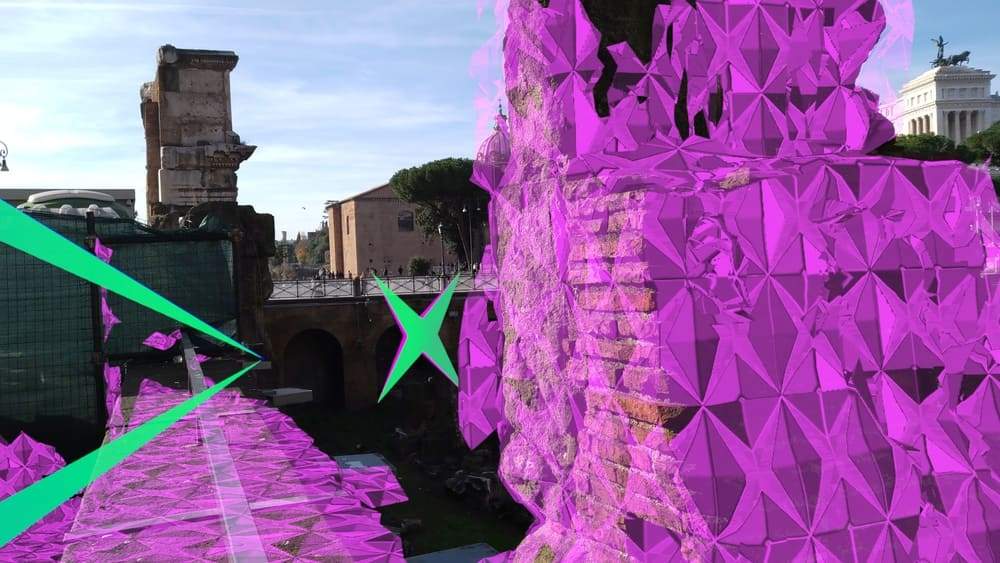Rome, Vincenzo Marsiglia proposes a digital artwork trail at Visionarea
In Rome, Visionarea ArtSpace, one of the city’s contemporary venues, just a few meters from St. Peter’s Basilica, inaugurates its 2023 with the exhibition Physis and rendering, a solo show by Vincenzo Marsiglia (Belvedere Marittimo, 1972), curated by Davide Silvioli with the collaboration of Davide Sarchioni, which can be visited from February 1 to March 25, 2023. An artist with a profound interdisciplinary aptitude-with appearances at the Venice Architecture Biennale, Fondazione Dino Zoli in Forlì, Casa del Mantegna in Mantova, Museo di Palazzo Collicola in Spoleto, and Museo del Presente in Rende-for the occasion, Vincenzo Marsiglia proposes a path between holographic NFTs and digital photographs, augmented reality and hololens glasses for a close encounter with the new frontiers of contemporary art, between digital and real.
The works on display range, in fact, from respective outcomes of the Fold, Modus, Star stone, and Prospect series, to holographic NFTs and digital photographs executed with the Hololens 2 device: the latest generation mixed and augmented reality visor, applied for the first time in the field of visual arts research by Marseille himself.
Physis and rendering (an exhibition organized with the support of the Culture and Art Foundation, an instrumental entity of the Fondazione Terzo Pilastro - Internazionale) thus connects a circle of works distinctive of the research directions undertaken by the artist during his multi-year career, to the point of returning a synthetic and paradigmatic version.
“The exhibition,” writes curator Davide Silvioli, "deepens the complexity of the artist’s work through a critical reading key aimed at establishing continuity between results due to different processes. From the tangible reality of physis to the virtual reality of rendering, the identity of the project replicates the faculty of Marseille’s research of being able to inhabit both these hemispheres of the real, detecting points of contact. A constant term in a lexicon evidently declined in the plural is the well-known Marseilles Unit (UM): a graphic module in the shape of a four-pointed star. The latter corresponds to the fundamental entity of his aesthetic universe, the indivisible unity of all artistic experience. As a generator and narrator of alternative and complementary contexts, the UM logo, about the latest developments in Marseille’s activity, in which there is an increasingly significant recourse to technology, transitions from the properties of physical matter to the functions of digital media such as lcd monitors, ledwalls, and viewers."
“Vincenzo Marsiglia’s peculiarity lies in always finding new ways to work on augmented reality and develop in innovative ways the possibility of interacting with real space through technology,” comments Emmanuele Emanuele, President of the Fondazione Terzo Pilastro. "The artist’s interest focuses in particular on the physical/digital dialogue, which is the means to relate the visionary dimension of those who make art to the concrete and tangible world around us. Thanks to the Foundation that I am honored to preside over, I have already given space in 2021, at Palazzo Cipolla, to this new frontier of artistic language, hosting the major anthological exhibition of Quayola, one of the major exponents of media-art at the international level: like Quayola, Marseille helps us to think and understand the time in which we live, using the right language to express a vision of the world of the 21st century. The exhibition Physis and rendering thus qualifies as a true experiential journey, where the power of technologies is also this: to make people live new experiences and create unprecedented visions."
Vincenzo Marsiglia was born in Belvedere Marittimo (CS), in 1972. He studied at the Imperia Art Institute and the Brera Academy of Fine Arts, Milan, graduating in painting. He began his exhibition activity in the 1990s, with solo and group exhibitions in galleries, museums and public spaces, in Italy and abroad. He teaches at the Accademia di Belle Arti Aldo Galli - IED in Como and the Accademia di Belle Arti Santa Giulia in Brescia. His research originates from a visual element corresponding to a four-pointed star, which has become, over time, a distinctive component of his work; an authentic “logo” of the artist. The compositional aspect of his works seems to reflect an obsessive practice, generating ever new outcomes in which this symbol permeates with fabrics, ceramics, stone, glass, paper, articulating itself according to continuous variations of rhythm and form. His aesthetics, in terms of rigor and balance, can be traced back to the tradition of Geometric Abstraction, Minimalism, and Optical art. In the last cycles of works, the artist experiments with the use of technologies to test the properties of his language in function of new expressive solutions. Works of this type manifest a new consideration of contemporaneity, linked to the tools of communication that characterize it. The purpose is to achieve a category of mutable artwork, in power to complement itself with the interaction with the viewer.
For all information you can visit Visionarea’s website.
Image: Vincenzo Marsiglia, Map (star) the world (2022)
 |
| Rome, Vincenzo Marsiglia proposes a digital artwork trail at Visionarea |
Warning: the translation into English of the original Italian article was created using automatic tools. We undertake to review all articles, but we do not guarantee the total absence of inaccuracies in the translation due to the program. You can find the original by clicking on the ITA button. If you find any mistake,please contact us.




























